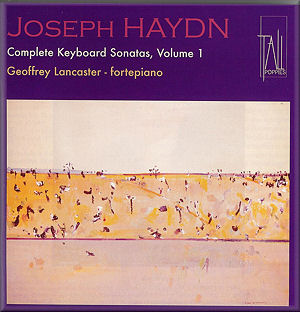 |
 |
|


|
Joseph HAYDN (1732–1809)
Complete Keyboard Sonatas - Volume 1
Sonata No.32 in G minor Hob.XVI:44 (c.1770) [15:30] prefaced by a Prelude in G minor composed prior to recording using elements of preludes by Joseph Diettenhofer and John Burrowes [0:46]
Sonata No.31 in A flat major Hob.XVI:46 (c.1767-68) [25:46] prefaced by the Prelude in A flat major by Muzio Clementi [0:26]
Sonata No.33 in C minor Hob.XVI:20 (1771/1780) [23:16] prefaced by the Prelude in C minor by Muzio Clementi [0:20]
 Geoffrey Lancaster (fortepiano) Geoffrey Lancaster (fortepiano)
rec. Llewellyn Hall, Australian National , College of Arts and Sciences, School of Music July 2009
 TALL POPPIES TP201 [66:22] TALL POPPIES TP201 [66:22] 
|
|
|
This is the first volume in a projected set of the complete Haydn keyboard sonatas from Geoffrey Lancaster, whose sense of the combative has been toned down in his erudite and extensive sleeve-notes, which read very well. Once or twice he casts a cocked eyebrow at contemporary performance practice, but the injudicious swipes I disliked when reviewing another of his discs are absent, thankfully.
The recording project mirrors performances given by Lancaster in his native Australia and he draws upon instruments in the Canberra School of Music. In this initial release he plays a Paul McNulty replica (made in Divisov in the Czech Republic in 2008) of a 1788 fortepiano made by Johann Andreas Stein.
A novel feature introduced is to preface the sonatas with preludes, a practice he notes of which only a few current performers avail themselves. An improvised prelude was hardly unknown in the eighteenth and nineteenth century. In fact there are even some early recorded performances on 78 of pianists modulating from one piece into another, which perhaps derives from the preluding practice. The first prelude was composed just before the sessions and Lancaster draws on preludes by Joseph Diettenhofer and John Burrowes to concoct his own. The other two are by Clementi.
The performances of the sonatas are marked by playful freedoms. One feels Lancaster is pushing the boundaries of the metrical spine of the music the better to suggest its audacity and individuality. He clearly relishes the droll pay-off of the finale of the G minor’s finale. Similarly one finds him exploring the harmonic twists and turns of the A flat major with considerable fixity, at the expense, unsympathetic auditors will note, of a regular pulse. His flexible tempi are certainly extreme and sometimes come to a full stop, restart, and continue. That said he explores the extremes of the sound world most capriciously in the slow movement of this sonata – it is remote, reserved, almost ascetic. Whether you will follow Lancaster throughout its eleven and a half minute duration is an interesting question.
The sense of communing, musing and an interior monologue is at its most pronounced in the opening movement of the C minor. This is played as something of a wistful Parnassus, its vast vista seen reflectively, then moving forward strongly. It’s rather as if the music were being anatomised by inches. It courts pulse-less introspection at many a turn and left me unconvinced. One feels at moments like this that Lancaster’s search for extremes both of sonority and tempo is a result of his trying too hard to convey the uniqueness of the music. His embellishments and tempo variations are part of a constant attempt to convey the sense of immediacy and composed-whilst-playing element of the experience of listening to the disc. This is further magnified by the recording itself which is very close-up. It certainly gives a zing to the sound of his fortepiano but there are also mechanical sounds audible – something of a hum – as well as some shuffling and sniffing, so you will need to tame the volume somewhat.
These are certainly provocative readings. Whether you will be enchanted, provoked or infuriated is very much a matter of taste.
Jonathan Woolf
Provocative readings. Whether you will be enchanted, provoked or infuriated is very much a matter of taste.… see Full Review
|
|

